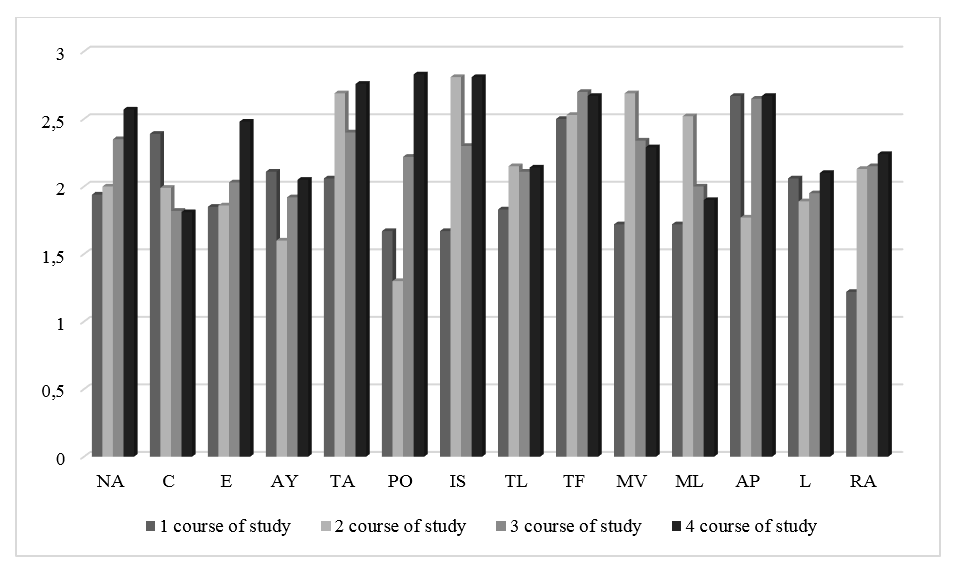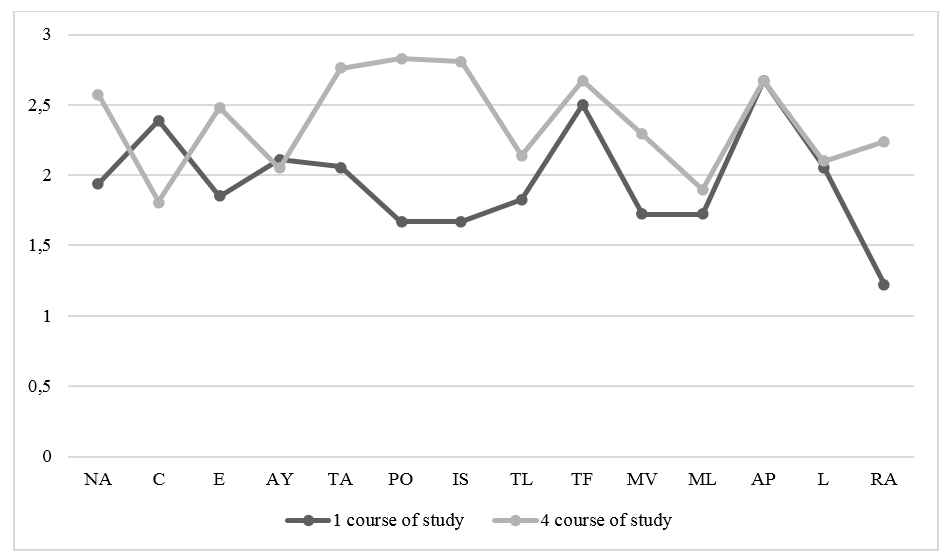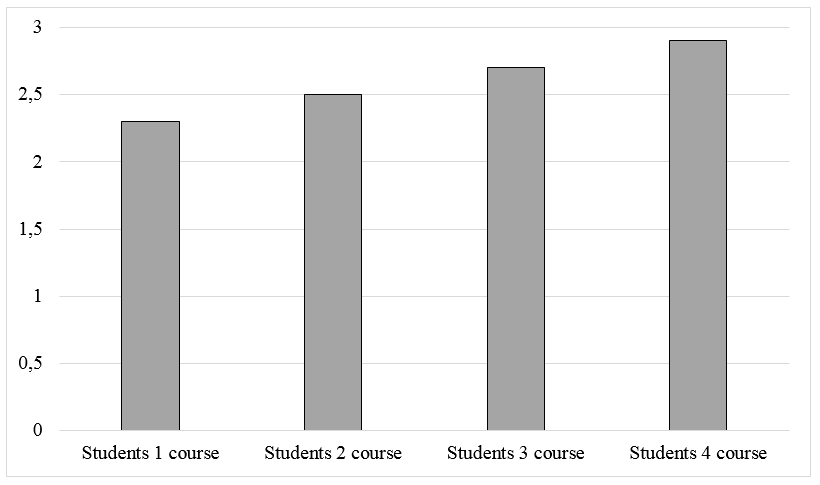Abstract
The authors consider readiness for learning as the basis of professional development, a component of professional culture, which determines the level of professional achievements of a specialist in modern society. Readiness for learning is studied in the paradigm of the system-genetic approach in psychology and is defined as an integral mental quality, the internal psychological basis of which is the structure of the individual qualities of a person that determine the success of training (qualities required for training). A conceptual model of the psychological structure of readiness for learning of students of pedagogical high school, consisting of five functional blocks qualities required for learning is worked out. The article presents the results of the research of the main indicators of the dynamics of students ' readiness for vocational training at high school. The empirical study was conducted on students of pedagogical University of different courses, the total group – 80 people. It is established that in the process of professional training the indicators of quality required for learning development increase, their interrelations are improved, the psychological structure of readiness for training as a whole is optimized. The most significant development effect was noted in relation to quality required for learning: professional orientation, task acceptance, introduction skills, attention performance, arbitrary regulation of activity, empathy, verbal memory. The development of readiness for learning is an indicator of the development of professional culture of students in the process of studying at high school
Keywords: Professional culturereadiness for learningprofessional culturereadiness for learning
Introduction
Problem Statement
Research of dynamics of indicators of quality required for learning development and psychological structure of readiness for learning as a whole is of scientific and practical interest.
Research Questions
For empirical investigation and solving the identified problems the objectives of the study are defined.
Purpose of the Study
The purpose of the study was to determine the components of the psychological structure of the readiness of students to learn at high school as a component of professional culture and its dynamics at different stages of vocational training at high school/
Research Methods
Findings
The conceptual model of readiness for learning includes five functional blocks qualities required for learning (Table
On the basis of the correlation analysis it is established that all theoretically selected qualities required for learning are included in the structure of readiness for learning, they form significant relationships with each other.

It is established that qualities required for learning in the process of vocational training at high school develop unevenly. Three types of dynamics qualities required for learning are established.
1. A steady increase in the rate of development (the need to achieve, empathy, arbitrary regulation of activity).
2. A sustainable decline in development rate (communication).
3. Reduction and increase of the development index during the period of training (attitude to yourself, task acceptance, professional orientation, verbal memory, logical memory, attention performance).
4. The absence of significant changes in the development index (thinking flexibility, learnability).
The difference in the types of dynamics qualities required for learning is due to their specificity. Some qualities are stable personality traits; at student age, they reach the highest possible level of development and do not change under the influence of vocational training. Other qualities have internal dynamics and are sensitive to learning.
In general, the dynamics of development indicators qualities required for learning reflects the restructuring of the mental mechanisms for the implementation of activities in the process of vocational training. The positive dynamics of indicators from the first year of study to the fourth year is identified (Figure

On the basis of statistical analysis, significant differences are identified in the development of such qualities required for learning students of the first and fourth courses of study as: empathy (P< 0,01), task acceptance (P< 0,001), professional orientation (P< 0,0001), introductory skills (P< 0,0001), logical thinking (P< 0,005), attention performance (P< 0,0001), verbal memory (P< 0,0001), arbitrary regulation of activity (P< 0,006). Significant differences in academic progress (P< 0.0001) and readiness for learning (P< 0.015) among students of the first and fourth courses of study are established.
The positive dynamics of the indicator of readiness for learning in the process of vocational training is revealed (Figure

Analysis of the results allows us to conclude about the positive dynamics of the structure of readiness for learning and its restructuring in the process of vocational training. The number of components of the structure at the beginning and at the end of undergraduate studies differs insignificantly, but the number of correlations increases significantly.
The weight of the component in the structure of readiness for learning of fourth-year students is significantly higher than that of first-year students. It allows making a conclusion about the active restructuring of the psychological bases of educational activity of students, the transition from the educational activities of the school type to educational and professional activities, about the beginning of the development of the actual professional activities. This conclusion is confirmed by structural indicators: the consistency and organization of the structure significantly increase by the fourth year of study, and the divergence indicator decreases
Conclusion
Readiness for training as a component of professional culture is developed and improved in the process of professional training. At the same time, the individual qualities of students necessary for the effective implementation of educational activities and the development of the teaching profession are actively developing. The most significant development effect was noted in relation to qualities required for learning: professional orientation, task acceptance, introductory skills, attention performance, arbitrary regulation of activity, empathy, verbal memory. At the same time the psychological structure of readiness for learning is actively developing, improving and optimizing, its consistency and organization is increasing. The development of readiness for learning is an indicator of the development of professional culture of students in the process of studying at high school.
Acknowledgments
The authors express their gratitude to the administration of Yaroslavl State Pedagogical University for creating conditions for the study.
References
- Ananyev, B. G. (1974). To psychophysiology of student age. In B.G. Ananyev, (Ed.), Modern psychological and pedagogical problems of the higher school (pp. 5-8). Leningrad: Leningrad Publishing House. Un-ta.
- Karpov, A. A., Karpov, A. V., Karabushchenko, N. B., & Ivashchenko, A. V. (2017). The interconnection of learning ability and the organization of metacognitive processes and traits of personality. Psychology in Russia: State of the Art, 10(1), 67-79.
- Kostromina, S. N., Mkrtychian, N. A., Kurmakaeva, D. M., & Gnedykh, D. S. (2017). The interrelationship between cognitive control and academic success of first-year students: An interdisciplinary study. Psychology in Russia: State of the Art, 10(4), 60-75.
- Ledovskaya, T. V. (2016) Psychological structure of educational activities of introverted students. Yaroslavsky Pedagogical Bulletin, 4, 161-167.
- Likhacheva, S., & Gabdulсhakov, V. (2018). Professional culture, pedagogical skills of kindergarten teacher: indicators and procedures of diagnosis. The European Proceedings of Social & Behavioural Sciences, 51, 483-492. DOI:
- Maslach, С. (1993). Professional burnout: Recent developments in the theory and research. Washington, DC: Taylor & Francis.
- Muzalev, A. A. (2014). Professional culture and its role in the formation of the professional qualities of a specialist in the conditions of a vocational school. Young Scientist, 4, 1040-1045.
- Nizhegorodtseva, N. V. (2018) Readiness for learning as a component of the professional culture. The European Proceedings of Social & Behavioural Sciences, 51, 823-829 DOI:
- Nizhegorodtseva, N. V., & Zhukova, Т. V. (2012). Comprehensive diagnostics of students' readiness for learning in a university (KDGs). Yaroslavl: Publishing House of YAGPU
- Orlov, A. A., Pazukhina, S. V., Yakushin, A. V., & Ponomareva, T. M. (2018). A study of first-year students’ adaptation difficulties as the basis to promote their personal development in university education. Psychology in Russia: State of the Art, 11(1), 72-83
- Osborne, M. J., & Thomas, E. J. (2003). Lifelong Learning in a Changing Continent: Continuing education in the Universities of Europe. Leicester: NIACE.
- Shadrikov, V. D. (2012). Students' development in the learning process. Psychology in Russia: State of the Art, 5, 388-404.
- Shadrikov, V. D. (2013). Psychology of human activity. Moscow: Publishing House of the Institute of Psychology of the Russian Academy of Sciences.
- Shuller, T., & Watson, D. (2009). Learning Through Life. Inquiry into the Future for Lifelong Learning. Leicester: NIACE.
- United Nation. (2015). Transforming our world: the 2030 Agenda for Sustainable Development. Retrieved from https://sustainabledevelopment.un.org/post2015/transformingourworld
- Zhukova, Т. V. (2016). Dynamics of qualities required for learning of students of a pedagogical university. Yaroslavsky Pedagogical Bulletin, 6, 285-289.
Copyright information

This work is licensed under a Creative Commons Attribution-NonCommercial-NoDerivatives 4.0 International License.
About this article
Publication Date
02 December 2019
Article Doi
eBook ISBN
978-1-80296-072-3
Publisher
Future Academy
Volume
73
Print ISBN (optional)
-
Edition Number
1st Edition
Pages
1-986
Subjects
Communication, education, educational equipment, educational technology, computer-aided learning (CAL), Study skills, learning skills, ICT
Cite this article as:
Nizhegorodtseva*, N., Zhukova, T., & Ledovskaya, T. (2019). Dynamics Of Readiness For Learning Of University Students. In N. I. Almazova, A. V. Rubtsova, & D. S. Bylieva (Eds.), Professional Сulture of the Specialist of the Future, vol 73. European Proceedings of Social and Behavioural Sciences (pp. 314-321). Future Academy. https://doi.org/10.15405/epsbs.2019.12.34
